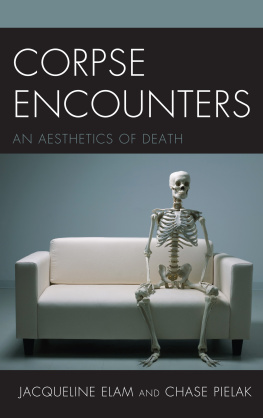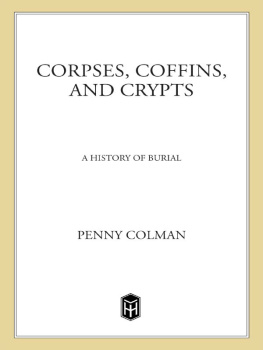
Thank you for downloading this Simon & Schuster eBook.
Join our mailing list and get updates on new releases, deals, bonus content and other great books from Simon & Schuster.
C LICK H ERE T O S IGN U P
or visit us online to sign up at
eBookNews.SimonandSchuster.com
C ONTENTS

To Jack, who kept me alive while writing this book, and to my parents, without whom I wouldnt be here in the first place.

A corpse is always a problemboth for the living and for the dead. The problems are both conceptual and practical: a dead body hovers uneasily between the animate and the inanimate, the past and the future. Even ordinary deaths often lead to questions about who has control over the memory and estate of the deceased. Famous corpses are more complicated still: not just family and friends but the church, state, admirers, and enemies often lay claim to the famous dead.
As a result, some of the most notable lives in history have had surprising postscripts. Famous corpses have been bought and sold, studied, collected, stolen, and dissected. Theyve been used to found churches, cities, and even empires. Pieces of them have languished in libraries and museums, in coolers and filing cabinets, and in suitcases underneath beds. These stories often have something to say about what the dead meant to the living: its no coincidence that Descartes lost his skull, Einstein his brain, or Rasputin his penis (supposedly).
This is a book about how the living have tried to solve the problems of the deador gotten them into even deeper troubleby using their bodies in different ways. Many of those uses have been political, religious, or scientific. Alexander the Greats bones established the Ptolemaic dynasty, the last in ancient Egypt, while the allegedly miraculous powers of relics from saints such as Thomas Becket made their bodies the hot commodities of the Middle Ages. The nineteenth-century pseudoscience of phrenology led to a rash of skull-stealing across Europe, which is how Haydn (to name but one example) lost his head. Criminals, too, have used corpses for their own ends, from the counterfeiters who tried to steal Abraham Lincolns coffin to the modern-day body snatchers who sold the bones of broadcaster Alistair Cooke.
The living have also used the dead simply for the consolation of memory. Bodies can become mementos, as when Mary Shelley kept Percy Shelleys heart, or when Greek independence fighters asked for Lord Byrons lungs. And famous corpses sometimes become museum pieces symbolic of genius or notoriety, which is what happened to the skulls of Mozart and the Australian outlaw Ned Kelly.
But the living dont always override the wishes of the deceased. The philosopher Jeremy Bentham left explicit instructions about turning his body into a statuestripped, stuffed, and mounted in a cabinet like an exotic bird. Musician Gram Parsons left an even weirder requestto have his body burned in the Mojave Desertbut that, too, was fulfilled, much to the chagrin of his family. Both Timothy Leary and Hunter S. Thompson also went out the way they wanted: with a bang, and major parties.
Strange as these stories are, this book intends to deliver more than a rich supply of inappropriate cocktail chatter. Although I dont believe in heaven or hell, its hard to deny that how you live often has something to do with what happens after you die. The postmortem journeys of controversial corpses (like that of Argentinas first lady Eva Pern) often look like a game of hot potato, while those of widely revered geniuses, like Beethoven, are stories of carefully guarded treasure. These tales can tell us something about their subjects, and the times and places in which they lived. What does it say about Voltaires France that he was terrified of his bones ending up in the trash? What does it say about Restoration England that Oliver Cromwell was posthumously hanged? What does it say about America that Lee Harvey Oswald was exhumed to make sure he wasnt a Russian spy?
The stories in this book also sketch the evolution of our attitudes toward death and mourning. Not so long ago, death was both more familiar and more sacred, and it wasnt so strange to keep a famous skull around, or to wear a ring showing off some strands of a dead friends hair. These attitudes have faded, but their shadows remain. Putting the pieces back together might help us understand famous figuresand our own ancestorsa bit better.
Ive collected these strange stories with that goal in mind. But humans have been dying as long as weve been living, so a book like this could easily run to several volumes if I didnt set some boundaries. For one thing, everyone in these pages was famous before becoming a corpse. This is not just a book about all the weird things that can happen to any dead body, fun as that might be.
Secondly, while there are plenty of tall tales about famous bodies (my favorite being that Walt Disneys frozen corpse is buried beneath the Pirates of the Caribbean ride at Disneyland), Ive included only stories that could be documented. However, the history of the deceased is often murky territory, so where sources conflict, Ive presented multiple variants of a story, or chosen to trust the most-respected source. For those who want to take their own stab at unraveling the mysteries, theres an extensive bibliography at the back of the book.
Because the stories in this book reflect the culture of their time, youll notice a lot of dead white men. The corpses of women and people of color have also suffered many misadventures, but because most of their owners werent famous, they often didnt fit the framework of this booknot that this is a project anyone would clamor to be included in.
But while death troubles us, it also intrigues us. Death is the ultimate mystery, and contemplating it does us good. Kierkegaard said, The thought of death is a good dancing partner. The more you dance, the less you fear. This book is a form of exposure therapy, looking directly at the thing many of us most want to avoid. Spending time with famous dead bodies has made me worry a little less about the Grim Reaper. I hope that this book will do the same for you.
In the divided body, the grace survives undivided ...
THEODORET OF CYRUS ( CA . 393 CA . 458)
F or much of Western history, one institution has had more control than any other over the care of the dead: the Catholic Church. The Church has long been responsible for how Christian dead were handled, where they were buried, and even how they were mourned. Some of the deceased benefited from this arrangement: for saints, even the most mundane bits of bones, skin, and hair could be transformed into relics, objects imbued with divine presence and miraculous powers. But for those who criticized the church, death could be an obstacle course. Voltaires corpse had to be smuggled into the countryside (dressed as if he were still alive) just to get a decent grave, while the controversy surrounding the playwright Molires burial led to a case of mistaken identity in one of the worlds most famous cemeteriesa case that persists today.













